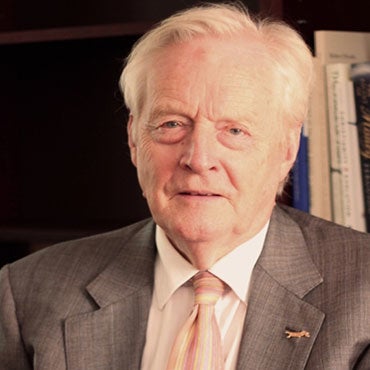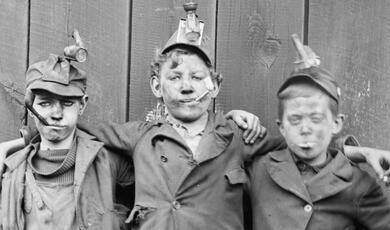The Future of London Government: 150 years in the making
Share
- Details
- Text
- Audio
- Downloads
- Extra Reading
Professor Tony Travers charts the historical development of London's government.
With an introduction by Stuart Fraser, Chairman, Policy and Resources committee, City of London. Opening remarks by Professor Sir Roderick Floud CBE FBA, Provost of Gresham College.
Download Text
24 May 2010 The Future of London Government: London's government: 150 years in the making Professor Tony Travers Origins Arrangements for governing London have been heavily influenced by the city's history and geographical scale. The Romans and the Saxons had city governments within or just to the west of today's City of London. William the Conqueror granted the City a charter in 1067, recognising the rights, freedoms and laws that had been granted by Edward the Confessor. During the Saxon and Norman periods, City business was largely handled by aldermen. The City has existed continuously as a unit of government since the early 1000s. The City of London's contemporary website states that: "The City of London is the oldest continuous municipal democracy in the world. It predates Parliament. Its constitution is rooted in the ancient rights and privileges enjoyed by citizens before the Norman Conquest in 1066. The City of London developed a unique form of government which led to the system of parliamentary government at local and national level"[1]. In 1215 the City was granted the right to elect a mayor. From 1285 citizens from each ward met with the aldermen about the common affairs of the city. By 1376 these meetings became formal and were constituted as the Common Council, gradually replacing the powers of the aldermen. A slightly expanded and modernised version of system still operates today. Although London expanded well beyond the City during the period from 1100 onwards, the City of London's writ did not extend over the whole of this wider urban area. Nearby Westminster became the seat of government and a major ecclesiastical centre, eventually evolving its own local government. By 1600 the City and Westminster had joined into a single urban area which continued to expand despite Tudor efforts to limit development. The industrialisation of Britain from 1750 led to the growth of many large cities which, one by one, after 1835 acquired municipal corporations to run their affairs. London, which was the biggest British city, notoriously retained a fragmented system of government with the City of London responsible for its historic area, a separate municipality at Westminster and many parish-based and ad hoc arrangements springing up in the urbanised areas outside these districts. The Victorian metropolis and the need for metropolitan government By the middle of the 19th century, London had become the biggest city in the world. Despite the creation of municipal corporations outside the capital, London remained unreformed. The City of London's resistance to change, including an unwillingness to take over neighbouring areas, coupled with the parochialism of the parishes and vestries that constituted the rest of the city's government, became an impediment to reform. Royal Commissions examined aspects of London's government in 1837 and 1854. Ad hoc efforts were made to consider sewers and water supply. In 1829 the Metropolitan Police service was created to provide a service across the metropolis. But no city-wide tier of government was introduced for the city as a whole. It took a major public health problem to create the impetus for reform. During the hot summer of 1854, the Thames became so noxious (the event was known as the "Great Stink") that Parliament created the Metropolitan Board of Works (MBW) to undertake improvement works within the area now known as "inner London"[2]. The MBW was a joint committee of the parishes, vestries and the City of London Corporation. As such it was a relatively weak institution. However, its chief engineer, Sir Joseph Bazalgette, proved to be both good at his job and politically astute. The Board built a system of sewers, the Embankment, a number of properly laid-out roads and other infrastructure. It also developed public services such as the fire brigade. However, by the end of its life in the 1880s the Board had become mired in accusations of corruption, and in 1888-89 it was replaced by an elected county council. The London County Council The London County Council (LCC) took over all the MBW's responsibilities and, within a few years, became the most powerful city-wide authority ever to have operated in London. Its remit came to include housing, health services (including hospitals), licensing, planning, transport and, after 1904, schools. It built a vast County Hall on the river at Lambeth. The LCC was a progressive and innovative institution, which built large quantities of social housing and developed an exemplary local health service. Its leaders, notably Herbert Morrison, lobbied central government to transfer additional powers over roads, transport and other provision to the LCC. In 1899 the government reformed the "local" level of London government, merging parishes and previously-merged "district boards" of vestries into 28 directly-elected "metropolitan boroughs". The City of London continued as a separate authority. Thus, from 1899 onwards London had two tiers of elected local government: at the "metropolitan" and "local" levels. The boroughs were responsible for local services such as refuse collection, streets, lighting and recreation. However, the LCC was significantly more powerful than the boroughs, either individually or collectively. Separately from the elected tiers of government, other changes took place to London's governance. By far the most important was the evolution of the London Passenger Transport Board, under its charismatic chairman Lord Ashfield. Ashfield, like Bazalgette, pursued a single-minded policy of creating high-class London infrastructure. The Underground and bus network were extended well beyond the LCC's boundaries, deep into the Home Counties. Ashfield and Morrison were friendly foes, each with a powerful London "empire" to extend[3]. "Greater London" Even when the LCC was created in 1888-89 it did not cover the whole of the built-up area of London. To the east lay the county boroughs of East Ham and West Ham. During the early part of the 20th century London grew rapidly into the fields of Middlesex, Hertfordshire, Essex, Kent and Surrey. By the 1920s academics and commentators identified this continuously built-up metropolitan area as "Greater London" and began to suggest policies and government systems to accommodate the reality of what had become a vast city of eight million people. Professor William Robson of the London School of Economics was a strong proponent of a "Greater London authority" of some kind[4]. A number of factors conspired to convince the Macmillan government to set up the Herbert Royal Commission, which from 1957 to 1960 examined London government. A continuous lobby from some professionals and academics was one factor. The problems of managing transport, traffic and planning over the whole of the London area was another. Third, the long-term dominance (since 1934) of the LCC by the Labour Party made it easier for a Conservative government to agree to set up an inquiry that might lead to a new authority with wider boundaries[5], covering Conservative strongholds. Herbert proposed a Greater London Council (GLC), to cover virtually the whole of the built-up area of London, with over 50 borough councils to provide a "local" tier of government. This proposal was accepted by the government, though it was decided to reduce the number of boroughs to 32, while making the GLC less powerful than the Royal Commission had suggested. The City of London would remain, alongside the boroughs. Thus, in 1965 the GLC came into being. It was responsible for planning, the fire brigade and some social housing. In 1970 London Transport (successor to the London Passenger Transport Board) was transferred to it. A Greater London Development Plan was developed over a number of years. Unlike the LCC the GLC changed political control from time to time. Although Labour won the first election, the Conservatives took control in 1967. It then switched back and forth until in 1981 Labour won the council. There was then a change of leadership within the Labour group which brought to power Ken Livingstone, a left-winger. As a result of the ensuing political struggle between the radicals at County Hall and Margaret Thatcher's radical Conservative government, the GLC was abolished in 1986[6]. The 32 boroughs and the City, by contrast, have operated continuously since 1965, making them long-term survivors by the standards of most British institutions of government. The boroughs were given responsibility for schools, social services, local planning, housing, environmental provision, local transport, highways and leisure. From 1965 till 1990, education in inner London was run by the Inner London Education Authority, a joint GLC-borough institution. From 1990 education was transferred to the inner London boroughs[7]. Interregnum and restoration In the years from 1986 to 2000 there was no metropolitan government in London. Some GLC services transferred to central-government departments, some to quangos, some to joint committees of the boroughs and some to the London Residuary Body (LRB), an ad hoc appointed body. Thus, the fire brigade became the responsibility of the London Fire and Civil Defence Authority, whose members were drawn from the boroughs. Strategic planning was transferred to the London region of the Department of the Environment in Whitehall. The LRB took responsibility for most GLC properties, including Hampstead Heath[8]. There were calls for the restoration of London-wide government even before the GLC's abolition. The Labour Party and the Liberal Democrats supported the creation of a new metropolitan tier. When Labour returned to power in 1997, it was committed to a new form of London government with a directly-elected executive mayor and an assembly which, together, were to be known as the Greater London Authority (GLA). The new authority was created in 2000, a year after devolution to Scotland and Wales. The GLA was given responsibility for transport, city-wide planning, economic development, the fire service and some control over the Metropolitan Police. In 2007 its remit was extended to include additional powers over housing funding and waste[9]. The 32 boroughs continued as they had since the boroughs took office in 1965. The City of London, as ever, retained its unique position. Thus, from 2000 onwards London returned to a two-tier system of government. The mayor was a 'strong mayor' with relatively limited powers, facing a weak Assembly, while the boroughs remained powerful within their areas. The GLA pioneered a new democratic institution in the United Kingdom - a directly-elected executive mayor. There have been two incumbents so far, one a Labour politician and one a Conservative. After ten years of operation there are no voices raised to suggest the GLA's abolition. This silence suggests the model now in operation will continue for some time. Indeed the new Conservative/Liberal Democrat government elected in 2010 looks set to devolve more powers to the mayor of London. Conclusions In the period since the end of the 19th century New York City has had one, virtually unchanged, system of metropolitan government - and even the 1898 reform merely involved the incorporation of Brooklyn and three outer boroughs. In the same period London's "local" tier of government has had three different forms and the city-wide tier has changed four times (1888, 1965, 1986 and 2000). As is true for many aspects of British public administration, London government is subjected to relatively regular change. In part the need for reform has been driven by London's epic growth. But there has also been upheaval because of political actions at the national level which probably did not have the quality of London's government as their primary objective. Both the creation and abolition of the GLC were highly-political events. All politics is political, and the local government of London by two sets of politicians within a framework of laws set by Parliament will always be subject to the random intelligence, whim and prejudice of politicians. London's skyline is physical evidence of the extent to which politicians can influence the city. If the skyline looks unplanned and messy, it is because every tall building and much of the modern shape of London has been determined by political decisions which were fragmented by time and institutional approach. Why should other aspects of government be significantly different? London has prospered notwithstanding government systems. This is not to say that what government delivers is unimportant. The city could not function without the sewers, water supplies, roads, railways and public services organised and provided by its government. But much of the commercial and social progress made over the centuries has occurred because of the efforts of developers, companies and individuals. Politicians are probably more convinced of the efficacy of reforms to government structures than anyone else. The city itself just carries on ©Professor Tony Travers, 2010 [1] City of London Corporation, http://www.cityoflondon.gov.uk/Corporation/LGNL_Services/Leisure_and_culture/Local_history_and_heritage/Buildings_within_the_City/Mansion_house/History+of+the+Government+of+the+City+of+London.htm [2] Stephen Halliday, The Great Stink of London Sir Joseph Bazalgette and the Cleansing of the Victorian Capital, Sutton, 1999 [3] Bernard Donoghue and G. W. Jones Herbert Morrison: portrait of a politician, Phoenix Press, 2001 [4] William Robson, The Government and Misgovernment of London, Allen & Unwin, 1948 (Second edition) [5] Gerald Rhodes (ed), The Government of London: The Struggle for Reform, Weidenfeld and Nicolson, 1970 [6] Tony Travers, The Politics of London Governing and Ungovernable City, Macmillan, 2004 [7] Tony Travers, George Jones, Michael Hebbert and June Burnham, The Government of London, Joseph Rowntree Foundation, 1991 [8] Michael Hebbert and Tony Travers (eds), The London Government Handbook, Cassell, 1988 [9] Ben Pimlott and Nirmala Rao, Governing London, OUP, 2002
Part of:
This event was on Mon, 24 May 2010
Support Gresham
Gresham College has offered an outstanding education to the public free of charge for over 400 years. Today, Gresham College plays an important role in fostering a love of learning and a greater understanding of ourselves and the world around us. Your donation will help to widen our reach and to broaden our audience, allowing more people to benefit from a high-quality education from some of the brightest minds.


 Login
Login











